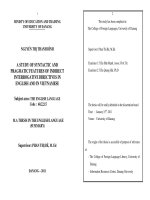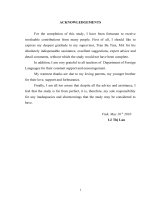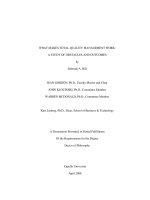A study of detection of enantiomers and chemical analogues by molecular imprinted polymer coated quartz crystal microbalance technique
Bạn đang xem bản rút gọn của tài liệu. Xem và tải ngay bản đầy đủ của tài liệu tại đây (740.15 KB, 85 trang )
A STUDY OF DETECTION OF ENANTIOMERS AND
CHEMICAL ANALOGUES BY MOLECULAR
IMPRINTED POLYMER COATED QUARTZ CRYSTAL
MICROBALANCE TECHNIQUE
BY LIU XIAO
NATIONAL UNIVERSITY OF SINGAPORE
2006
A STUDY OF DETECTION OF ENANTIOMERS AND
CHEMICAL ANALOGUES BY MOLECULAR
IMPRINTED POLYMER COATED QUARTZ CRYSTAL
MICROBALANCE TECHNIQUE
BY LIU XIAO
(B. Sc., Jilin University)
A THESIS SUBMITTED
FOR THE DEGREE OF MASTER OF SCIENCE
DEPARTMENT OF CHEMISTRY
NATIONAL UNIVERSITY OF SINGAPORE
2006
Acknowledgement
I would like to express my deepest gratitude to my supervisors, Professor Hardy Chan
for his invaluable guidance of this work. His encouragement, support and friendly
personalities were helpful and precious to the success of this research work and will
always remain in my mind.
I deeply appreciate the kind assistance from, Dr. Zhang Weiguang, and Dr. Xiao
Changyou; Particularly I will appreciate to the great help from Dr. Liu Feng for his
stimulating discussion and useful suggestions.
I also profoundly give my sincere thanks to my colleagues and friends who studied
and worked in the same research laboratory, Haibing Xia, Xuedong Zhou, Daming
Chen, Weihua Tang, Lee Teck Chia, Sheng Zhang, Huijuan Che, particularly Mdm
Frances for her generous help and priceless discussion during the research.
Last but not least, I also want to thank National University of Singapore for awarding
the research scholarship and for providing the facilities to carry out the research work
reported herein.
i
Table of Contents
Acknowledgment
Summary………………………………………………………………v
List of Tables………………………………………………………….vi
List of Figures……………………………………………………… vii
List of Abbreviations Symbols……………………………………….ix
1. Chapter one: Introduction…………………………………………1
1.1 Principle, function of binding groups, and general
application of molecular imprinted polymers (MIPs)…… 1
1.1.1 Principle of the Molecular Imprinted Polymers……………….1
1.1.2 Function of the Binding groups…………………………………5
1.1.2.1 Noncovalent interactions……………………………….6
1.1.2.2 Covalent interactions………………………………… 7
1.1.3 Applications of Molecular Imprinted Polymers………………10
1.1.3.1 Liquid chromatography……………………………….10
1.1.3.2 Solid phase extraction………………………………….11
1.1.3.3 Binding assays………………………………………….11
1.1.3.4 Sensors………………………………………………….12
1.1.3.5 Catalysis……………………………………………… 13
1.2 Principle and applications of Quartz Crystal Microbalance
(QCM)……………………………………………………… 14
1.2.1 Principle………………………………………………………….15
ii
1.2.2 Mass Sensitivity………………………………………………… 17
1.2.3 Applications of Quartz Crystal Microbalance…………………18
1.2.3.1 Gas phase detection…………………………………….19
1.2.3.2 Immunosensors…………………………………………19
1.2.3.3 DNA-based sensors…………………………………… 20
1.2.3.4 Detection of Cells……………………………………… 21
1.3 Combination of Molecular Imprinted Polymers and Quartz
Crystal Microbalance………………….……………………… 22
1.4 Research projective and scope……………………………… 26
2. Chapter two: Experimental……………………………………… 28
2.1 Materials………………………………………………………29
2.2 Synthesis of functional monomer………………………… 29
2.3 Procedures for Modification and Characterization of the
Surface of QCM…………………………………………… 30
2.3.1 Self-assembly of thiol groups onto the gold electrode………………30
2.3.2 File preparation and polymerization……………………………… 31
2.3.2.1 MIPs for L-try……………………………………………….31
2.3.2.2 MIPs for SMZ……………………………………………… 32
2.3.3 Instrumentation……………………………………………………….33
2.3.3.1 QCM systems……………………………………………… 33
2.3.3.2 Atomic force microscopy (AFM)……………………………34
2.3.3.3 Scanning Electron Microscope (SEM)………………… …34
iii
2.3.3.4 UV spectroscopy…………………………………………… 35
2.3.3.5 Electrochemical measurement…………………………… 35
2.3.3.6 Measurement of the thickness of the MIPs films………….36
3. Chapter three: Result and Discussion…………………………… 37
3.1 Effect of enantioselective molecular imprinting polymer coated
QCM for the recognition of L- tryptophan…………………38
3.1.1 Characterization of the thiol monolayer and MIP film-modified
gold electrode………………………………………………………38
3.1.2 Response time and reproducibility of the QCM sensor………… 41
3.1.3 Sorption characteristics of the enantioselective sensor……………42
3.1.4 Influence of the cross-linking monomer concentration on the sensor
performance……………………………………………………… 45
3.1.5 Application of the enantioselective sensor…………………………47
3.2 Study of the detection of molecularly imprinted polymer coated
QCM for sulfamethazine (SMZ) and its chemical analogue
with novel methodology……………………………………….49
3.2.1 Choice of functional monomers…………………………………… 49
3.2.2 Effect of PVAc on the adsorption and thickness of MIPs………….53
3.2.3 Sorption characterization of SMZ-sensor………………………… 57
3.2.4 Characterization of polymer films with AFM and SEM………… 58
iv
4. Chapter four: Conclusion and further work…………………… 61
4.1 Conclusion…………………………………………………62
4.2 Further work………………………………………………63
References………………………………………………………………65
v
Summary
Molecular imprinted polymers (MIPs) and Quartz Crystal Microbalance (QCM)
techniques have been widely used in the detection and separation of chemical
compounds. In this work, a new quartz-crystal microbalance (QCM) sensor that
provides enantioselectivity to tryptophan enantiomers, with a high selectivity and
sensitivity, was fabricated by the use of the molecularly imprinted polymers (MIPs) as
the artificial biomimetic recognition material. The preparation of the thin permeable
film coatings on QCM surface is described as well as the results and discussion on the
sensitivity and selectivity of the coatings to tryptophan enatiomers under different
conditions. The influence of the cross-linking agent concentration on the sensitivity
and selectivity of the fabricated polymer films was investigated and optimized.
The combination technique of molecular imprinted polymers and QCM was also
applied in discriminating chemical analogues, sulfamethazine (SMZ) and
sulfamethoxazole (SMO). Some improvements were made to obtain the better
selectivity of the MIPs by incorporating poly (vinyl acetate) (PVAc) and
low-volatility solvent diethylene glycol dimethyl ether to facilitate better adsorption
by the formation of a more porous and open structure of the polymer. All of the
results show that good reproducibility, sensitivity and selectivity can be achieved.
And the thickness of the films is controllable. AFM and SEM are used to characterize
the morphology of the polymer film coated on QCM.
vi
List of Tables
Table 1.1 Covalent interactions during the imprinting process.
Table 1.2 Functional monomer and template utilized in the combination technique
Table 2.1 Synthesis condition of SMZ MIPs
Table 3.1 Sensitivity and enantioselectivity of the QCM Sensors
Table 3.2 UV results of interactions between SMZ and functional monomers
Table 3.3 Amount of PVAc and water absorbed
vii
List of Figures
Figure 1.1 Schematic representation of interaction in imprinted polymers
Figure 1.2 Schematic representation of process of adsorption and desorption in MIP
Figure 1.3 Schematic of a typical piezoelectric crystal.
Figure 1.4 AT-cut of a quartz crystal
Figure 1.5 Schematic representation of a MIP-coated QCM sensor.
Figure 3.1 AFM images gold electrode surface
Figure 3.2 Typical cyclic voltammogram of QCM electrode
Figure 3.3 Frequency change of the MIP-coated QCM sensor
Figure 3.4 Sorption characteristics of the enantioselectivity of QCM sensor
Figure 3.5 Scatchard plot for adsorption curve
Figure 3.6 Effect of the crosslinker on QCM sensor
Figure 3.7 Frequency change of QCM sensor for different enantionmeric composition
Figure 3.8 Structures of different functional monomers and analytes
Figure 3.9 UV spectra for SMZ and functional monomers
Figure 3.10 Proposal model for SMZ and AAM interaction
Figrue 3.11 The adsorption and selectivity of MIP-coated QCM
Figure 3.12 frequency change of the QCM as a function of concentration of PVAc
Figure 3.13 Thickness of MIP films
Figure 3.14 Sorption characteristics of the QCM sensor to the SMZ and SMO.
Figure 3.15 AFM images for SMZ-IMP
Figure 3.16 SEM images for SMZ-IMP
viii
List of Abbreviations Symbols
2-HEMA 2-hydroyethyl methacrylate
2-DAMA 2-(dimethylamino)ethyl methacrylate
AAM Acrylamide
AFM Atomic force microscopy
AIBN 2,2 -azobisisobutyronitrile
DADAP Diacryolyl-2,6-diaminopyridine
DAPA 2,2-Dimethoxy-2-phenylacetophenone
DEGDM Diethylene glycol dimethyl ether
D-try D-tryptophan
GMA Glycidyl methacrylate
HOAc Acetic acid
L-try L-tryptophan
MAA Methacryl acid
MIP Molecular imprinted polymer
NIP Non-imprinted polymer
PVAc Poly (vinyl acetate)
UV Ultra violet
1
Chapter 1
Introduction
2
1.1 Principle, type of binding, and general application of
molecular imprinted polymers (MIPs)
In view of the challenges in the environmental, medical, food process and defense
industries, there is a need for analytical methods with high sensitivity and accuracy.
Biological recognition agents such as antibodies, enzymes, and other receptor
molecules have been widely employed in analytical and diagnostic practices [1, 2].
Although these agents are highly specific and sensitive, they are labile, expensive, and
have a low density of binding sites. Hence there is a significant demand for robust and
stable receptor molecules that can mimic biorecognition elements such as antibodies
and enzymes. The technique of molecular imprinting provides a promising and
advantageous alternative to overcome the problems associated with biomolecules.
1.1.1 Principle of Molecular Imprinted Polymers
The concept of imprinting was first reported in 1949 by adsorbing different dyes in
silica by Dickey’s group [3, 4]. Originally it was introduced as a means to create
binding sites in synthetic polymers. The imprinting of organic polymers was first
reported by Wulff’s group in 1972 [5, 6, 7]. The technique has now matured and it has
become established in several disciplines owing to its ability to form stable, robust
materials with molecular selectivity for a wide variety of target compounds.
3
To obtain highly specific binding sites of a definite shape containing functional
groups in a predetermined orientation [5, 6, 7], the functional groups were bound in a
polymerizable form to a suitable template molecule (a) (Fig. 1.1). This monomer was
then copolymerized under conditions that led to the formation of highly cross-linked
polymers with chains in a fixed arrangement (b). After removal of the template,
polymers with well-defined cavities (c) were obtained, whose structure and
arrangement of functional groups were predetermined by the chemical nature of the
template. The functional groups in these cavities are located at various points in the
polymer chain, and are held in a definite mutual orientation simply by the
corss-linking. In this case, the stereochemical information is not carried by a low
molecular weight part of the molecule. Instead, the entire arrangement of the polymer
chains is responsible for the stereochemical structure. This is reminiscent of the
structure of the active centers of enzymes [8]. The relationship of the template to the
imprinted cavity corresponds to the key/lock principle proposed by Emil Fischer for
enzyme catalysis around 100 years ago [9].
Figure 1.1 Schematic representation of the imprinting of specific cavities in a
crosslinded polymer by a template with three different binding groups.
Pol
y
merize
(
a
)
(
b
)
Functional
monomer
Template
molecule
Crosslinke
r
P
r
e-assembl
y
Removin
g
tem
p
late
(
c
)
4
The polymerization of the template monomer B is an example of the imprinting
method. Extensive optimization studies were carried out on this system. The template
is phenyl-α-D-mannopyranoside A to which two molecules of 4-vinylphenylboronic
acid are bound by esterification with two OH groups of the sugar to give B.
O
O
B
O
O
O
O
B
O
OH
OH
CH
2
OH
OH
O
A
B
Boronic acid was chosen as the binding group (binding site) as it undergoes a rapid
and reversible reaction with diols. The monomer B is subjected to radical
copolymerization with large amounts of a cross-linking agent such as ethylene
dimethacrylate in the presence of an inert solvent (which acts as a porogen to give a
porous structure). This yields macroporous polymers with a large inner surface area
and a permanent pore structure. Up to 95% of the templates can be split off from
polymers of this type by treatment with water or methanol (Fig. 1.2) [12].
5
- a
+ a
C
D
Figure 1.2 Schematic representation of a cavity C obtained by polymerization of B.
The template can be removed with water or methanol to give D. Addition of a causes
the cavity to be reoccupied, giving C again. In this case, the binding of the template is
by covalent bonding. [12]
After the template has been removed, the polymer is equilibrated in a racemic mixture
of compound A. The experiment showed that the enantiomer used as the template is
preferably taken up.
1.1.2 The Function of the Binding groups
In the imprinting procedure, the binding groups have several functions. On the one
hand, the bond between the template and the binding group should be as strong as
possible during the polymerization to enable the binding groups to be fixed by the
template in a definite orientation on the polymer chains during cross-linking. Then the
templates should be able to be removed as completely as possible. The next very
important function is the interaction of the binding groups with the substrates to be
bound, for example, with the compound that acted as the template. This process
should be as fast and reversible as possible to enable application in chromatographic
6
separations or catalysis. Thus, although high activation energy is desirable for the first
function, it should be as low as possible for the two other functions [8].
1.1.2.1 Noncovalent interactions
Imprinting can be achieved by either noncovalent or covalent interactions. The most
widely used strategy, pioneered by Mosbach [9, 17], is based on noncovalent
interactions between specific functional groups on the polymerizable monomers and
the template in order to position the monomers in a specific spatial orientation prior to
polymerization. After polymerization and removal of the template, the functional
groups of the polymeric matrix can then bind the target through the same noncovalent
interactions. To ensure that, on average, as many interactions as possible occur during
the polymerization, the ratio of ligand monomer to template in the solution must be at
least 4:1 [13]. The interactions usually used in the noncovalent method are
electrostatic interaction, hydrogen bonding, π-π interaction, hydrophobic, hydrophilic
and Van der Waals forces. The most important type of noncovalent interaction is the
electrostatic one. For example, when imprinting with L-phenylalanine anilide in the
presence of methacrylic acid, the influence of this interaction on the selectivity was
thoroughly inverstigated [13, 14, 15, 16]. The strength of the interaction depends on
the pKa values of the methacrylic acid and the amine group in the anilide, on the pH
of the solution, and in some circumstances on competing ions present. By this method
high affinity binding sites can be generated using the noncovalent imprinting strategy;
7
however, the limitation is that the template and target must form a sufficient number
of noncovalent intermolecular interactions.
1.1.2.2 Covalent interactions
The other method is covalent approach [10] pioneered by Wulff and co-workers, who
utilized reversible covalent bonding between a polymerizable monomer and a
template molecule. After polymerization, these bonds were cleaved to liberate the
template and subsequently reformed in order to selectively bond the target. Covalent
imprinting strategy is very stable and selective. The commonly used covalent
interactions are list in table 1.1 [8].
Table 1.1 Covalent interactions during the imprinting process.
Polymerizable
binding group
Binding site to the
template
Type of bond Reference
4-vinylphenylboronic
acid
Diol Boronic acid ester [18, 19]
Amines Aldehyde Schiff base [20, 21]
Aldehydes Amine Schiff base [22, 23, 24, 25, 26]
Diols Ketone Ketal [27-30]
Hemiacetals Alcohols Full acetal [31]
Boronaphthalide Alcohol Boronic acid ester [24,22]
Acrylic acid Amine Amide [32, 33, 34, 35, 36]
Acrylic acid Alcohol Ester [37, 38, 39]
4-vinylphenyl Alcohol Ester [40]
8
carbonate
Cobalt chelate Amino acid Chelate complex [41, 42]
Copper chelate Imidazole Chelate complex [43, 44, 45, 46]
Alcohols Carboxylic acid Ester [47, 48]
Vinylimidazole+Co
2+
Amino acids Chelate complex [49]
The boronic acid group is very suitable for covalent binding. Poly(vinylphenylboronic
acid)s are commercially available and are used in chemoselective affinity
chromatography in alkaline aqueous solution for diol-containing compound [50].
They can also be used in a similar way for imprinting. The advantage is that relatively
stable trigonal boronic acid esters are formed [Eq. (a)]. However, in aqueous alkaline
solution or in the presence of certain nitrogen bases (for example, NH
3
, piperidine)
tetragonal boronic acid esters are formed [Eq. (b)], which equilibrate extremely
rapidly with tetragonal boronic acid and diol [18, 19]. In these cases, the rate of
equilibration is comparable to that for noncovalent interaction. However, for most of
the covalent interactions, the number of functional groups to react with template in the
imprint is limited. At high concentrations very rigid imprint formation occurs. For
practical repetitive use the cleavage and rebinding may be limited and problematic
due to the limited interactions.
9
B(OH)
2
R
HO
HO
B(OH)
2
R
HO
HO
N
H
B
R
O
O
B
R
O
O
N
H
2H
2
O
2H
2
O
+
+
Eq. (a)
+
+
Eq. (b)
Covalent interactions have the advantage that the binding groups are precisely fixed in
space during the polymerization, which should provide more homogeneous binding
sites, however the re-binding is slower due to the necessary formation of the covalent
bond between template and MIP, and is more cumbersome requiring prior
derivatization of the template. With noncovalent interactions, a considerable excess of
binding groups is required in the polymerization mixture so that the biding sites in the
template are completely saturated at equilibrium. The template is usually very easily
removed and reversible interactions with substrates are, in principle, rapid, although it
may generate heterogeneous binding sites due to the relatively weak interactions
utilized. When producing chromatographic materials for analytical purposes,
noncovalent interactions are usually preferred, as the materials are more readily
obtainable and an excess of binding groups apparently does not have a detrimental
effect on the separations. For the constructions of catalysts, the orientations of the
binding groups and catalytically active groups in the cavity are of greater significance,
so that covalent interactions should be more advantageous here [8]. Attempts have
been made to combine the advantages of both the covalent and noncovalent approach,
whereby imprinting is carried out using polymerization of the functional monomer
10
being covalently coupled to a template, and selective rebinding utilizing non-covalent
interactions [11].
1.1.3 Application of Molecular Imprinted polymers
1.1.3.1 Liquid chromatography
The first application of MIPs was as stationary phases in affinity chromatography, in
particular for the enantioseparation of racemic mixtures of chiral compounds, and
much of the early work on MIPs was devoted to this aspect. The imprinting process
introduces enantioselectivity into polymers that are synthesized from (in most cases)
non-chiral monomers. The particularity of MIPs compared with conventional chiral
stationary phases is that they are tailor-made for a specific target molecule, hence
their selectivity is predetermined. For example, if a polymer is imprinted with the
L-enantiomer of an amino acid, an HPLC column packed with the MIP will retain the
L-enantiomer more than the D-enantiomer and vice versa, whereas a column
containing an identical but non-imprinted polymer will not be able to separate the
enantiomers. Typical values for the enantioseparation factor a are between 1.5 and 5,
although in some cases much higher values have been obtained. If the molecule of
interest contains more than two chiral centers, as is the case with carbohydrates, these
properties of molecularly imprinted materials become even more relevant; in a study
in which polymers were imprinted against a glucose derivative, very high selectivity
11
between the various stereoisomers and anomers were recorded [51].
1.1.3.2 Solid phase extraction
The application of molecular imprinting in the analytical separation field most close
to practical realization is probably that of solid phase extraction, SPE. Several groups
have already applied MIP-based solid phase extraction to biological and
environmental samples and this technique may well be accepted generally in the
not-to-distant future [52]. Benefits of the technique are the selectivity of the MIP can
be pre-determined by the choice of template employed for its preparation, which
combined with the high selectivity of the sorbent lead to efficient sample clean up.
Also, the ability to improve sensitivity by extracting larger sample volumes has been
mentioned. This is particularly interesting for trace analysis of environmental samples.
Being a novel technique most studies published until now have dealt with the
preparation of the selective MIP, and optimization of experimental conditions to
obtain quantitative extraction of the sample and elution of the analyte into a small
volume [52].
1.1.3.3 Binding assays
MIPs have been employed as non-biological alternatives to antibodies in a
competitive radiolabelled molecularly imprinted sorbent assay, MIA [53]. The assay
12
is analogous to that of a competitive immunoassay, or limited reagent assay. Sample,
containing analyte, and a fixed concentration of marker, a labelled derivative of the
analyte, are incubated with a limited number of antibody binding sites or imprints.
Analyte and marker compete for binding to the same sites and, hence, the amount of
labelled marker bound to the antibodies or imprints is quantitatively related to the
amount of analyte added to the incubation mixture [54]. Interest in this technique is
due to MIPs combine highly selective molecular recognition, comparable to
biological systems, with typical properties of polymers such as high thermal, chemical
and stress tolerance, and extremely long shelf-life without any need for special
storage conditions. In MIA the most commonly used label is a radioactive isotope, but
also detection systems based on fluorescence have been suggested [54]. For MIA to
become accepted generally one critical point is the introduction of efficient and
easy-to-use non-radioactive techniques. An innovative technical improvement is the
use of magnetic MIP beads to facilitate separation of free and bound radiolabelled
marker [55]. Also, sub-micron beads, more resistant to precipitation and aggregation
and, hence, requiring less agitation during incubation, may simplify the assay
procedure [56].
1.1.3.4 Sensors
In chemical sensors and biosensors, a chemical or physical signal is generated upon
the binding of the analyte to the recognition element. A transducer then translates this
13
signal into a quantifiable output signal. The same general principle applies if an MIP
is used as the recognition element instead of a biomolecule. Certain general properties
of the analyte (such as its IR spectrum) or changes in one or more physico-chemical
parameters of the system (such as mass accumulation or adsorption heat) upon analyte
binding are used for detection. In the past few years, MIPs have been utilized as a
molecular recognition membrane or layer on chemical-sensing systems in
combination with transducers such as quartz crystal microbalances (QCMs) [57],
surface plasmon resonance devices [58], field-effect devices [59], conductometry [60],
or impedometric determination [61]. This principle is widely applicable and more or
less independent of the nature of the analyte. Alternatively, reporter groups may be
incorporated into the polymer to generate or enhance the sensor response. In other
cases, the analyte may possess a specific property (such as fluorescence or
electrochemical activity) that can be used for detection.
1.1.3.5 Catalysis
In many cases, enzymes exhibit low catalytic activities due to the presence of organic
solvents, inhibitors, and/or complex mixtures and perturbations in the temperature and
solution pH. These problems may be avoided by employing synthetic biomimitic
catalytic counterparts [62] instead of biomolecules such as enzymes and catalytic
antibodies [63]. The catalytic counterparts can be synthesized by tuning the enzyme
active site through molecular imprinting with substrates or their transition state
14
analogues (TSAs) [64–66]. For the preparation of catalytically active MIPs, a cavity
has to first be made with a defined shape corresponding to the shape of the substrate
or, even better, to the shape of the transition state of the reaction. At the same time,
functional groups are incorporated that act as binding sites, coenzyme analogs, or
catalytic sites within the cavity and in a defined stereochemical manner [67]. These
artificial polymeric catalysts are more durable and more resistant to harsh
environments than biomolecules [68, 69], thus they may be highly advantageous for
industrial continuous transformation and/or conversion reactions.
1.2 Principle and applications of Quartz Crystal
Microbalance (QCM)
The signal transduction mechanism of the QCM technique relies upon the
piezoelectric effect in quartz crystals, first discovered in 1880 by the Curie brothers,
via a pressure effect on quartz [70]. A change in inertia of a vibrating crystal was then
shown by Lord Rayleigh to alter its resonant frequency, f [71]. Important subsequent
developments were good crystal stability through the use of electric resonators [72]
and room-temperature stable AT-cut crystal [73]. In 1959, the QCM was first used in
a sensing mode when Sauerbray reported a linear relationship between the f decrease
of an oscillating quartz crystal and the bound elastic mass of deposited metal [74].
Early chemical applications of QCM were measuring mass binding from gas-phase
species to the quartz surface. These represented some of the earliest chemical sensors









